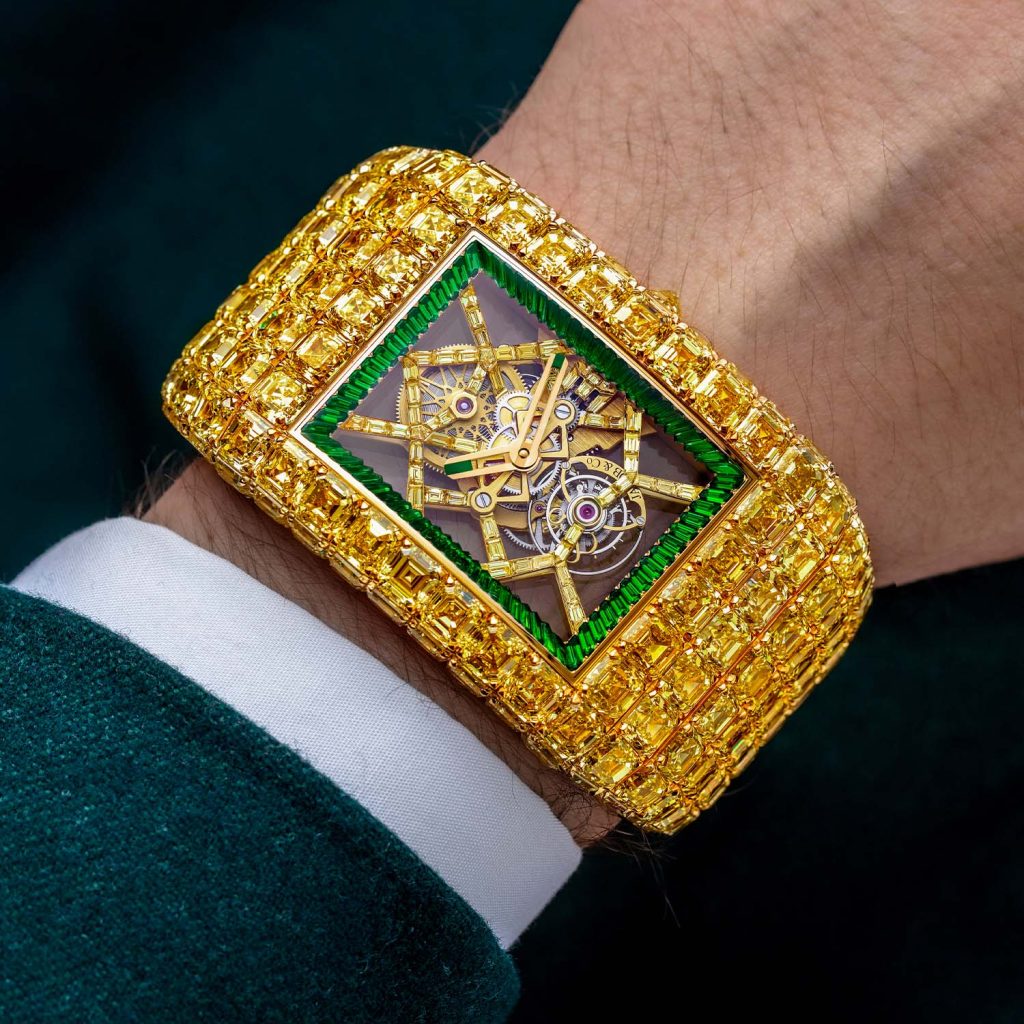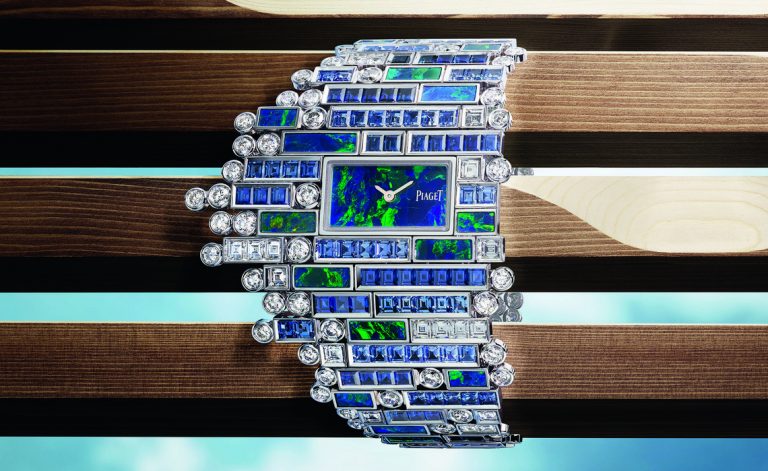There’s a particular kind of death that luxury brands inflict upon themselves, a slow suicide by a thousand iterations. It’s the death of mystique, the murder of impossibility, the systematic dismantling of everything that made something legendary in the first place. Jacob & Co. committed this crime again with the unveiling of their Billionaire III watch, and I’m tired of pretending this isn’t exactly what it is: the final nail in the coffin of what was once the most captivating timepiece in modern horology.
The Billionaire watch is dead. Not physically, of course. There are more versions of it now than ever before. But the dream? The awe? The sheer audacity that made it matter? Gone. And Jacob & Co. killed it themselves, one update at a time, transforming what should have remained a singular monument to excess into just another product line with color variations.
The Golden Age: When the Billionaire Was Actually Rare
Let me take you back to 2015, to Baselworld, when Jacob & Co. unveiled something that genuinely stopped the watch world in its tracks. The original Billionaire watch wasn’t just expensive; it was almost offensively opulent. Two hundred and sixty carats of emerald-cut diamonds, meticulously set across every visible surface. Not chips. Not accent stones. Emerald-cut diamonds, each one requiring perfect clarity, perfect color, perfect proportion to sit flush against its neighbor in an unbroken sea of brilliance.

The technical achievement alone was staggering. Do you know how long it takes to source 260 carats of gem-quality diamonds that match closely enough to create a cohesive whole? Years. Not months. Years of hunting through diamond markets, rejecting stones that weren’t quite right, waiting for the perfect specimens to surface. Then came the cutting, each diamond shaped specifically for its position on the watch. Then the setting, a microscopic dance of precision where a single slip would ruin stones worth hundreds of thousands of dollars.
The price tag? Eighteen million dollars. Not an estimate. Not “starting at.” Eighteen million dollars, firm, final, and frankly, beyond the reach of all but a handful of people on the planet. And that’s exactly what made it perfect.
When Floyd Mayweather bought the original Billionaire watch for that sum, it became more than a timepiece. It became a cultural moment. Here was a man known for his extravagance, someone who’d spent millions on cars, jewelry, and real estate without blinking, and even he was making headlines for this purchase. The watch transcended horology and entered the realm of mythology. It was the watch that even the ultra-wealthy had to think twice about. It was, in every sense that mattered, one of a kind.
That status, that singularity, that sense of “there is nothing else like this and there never will be”—that was the product. Yes, the diamonds were real. Yes, the craftsmanship was extraordinary. But what Jacob & Co. was really selling was impossibility made tangible. They were selling a story that would outlive the watch itself, a legend that would be whispered about in collector circles for generations.
And then they decided to kill it.
The Death by a Thousand Updates
The descent didn’t happen overnight. It never does. It started subtly, with the Billionaire II and the introduction of the “Millionaire” line, as if acknowledging that $18 million was perhaps a bit much. Then came the Billionaire Ashoka, with a different cut of diamond. Each iteration made sense in isolation. Why not offer options? Why not let more people into the club?
But 2016 is when things truly began to unravel. Jacob & Co. launched the Billionaire III, and here’s where the narrative started to collapse: they priced it at $3 million and produced eighteen pieces. Read that again. The watch that was supposed to represent the absolute pinnacle, the final word in luxury timekeeping, now had eighteen siblings, and they were selling for a sixth of the original price.

Fast forward to 2023, and Jacob & Co. tried to recapture the magic with the Billionaire Timeless Treasure, a $20 million piece featuring yellow diamonds. On paper, it was even more expensive than Mayweather’s. In reality, it was a desperate attempt to one-up themselves, to prove they could still create something “ultimate.” But the game was already over. Once you’ve made eighteen versions of the Billionaire III, you can’t go back and claim this new one is truly singular. We’ve seen this trick before.
And then, in 2024, came the final insult: the Billionaire III in Emeralds, Rubies, and Rainbow variants. Multiple colorways. As if we’re talking about a sneaker drop and not what was supposed to be the most exclusive watch ever made. These newer versions range from $2 million to $7 million, depending on the stones and configuration.
Do you see what happened here? Jacob & Co. took a concept that derived its entire value from being unrepeatable and turned it into a franchise. They took lightning in a bottle and decided to manufacture it on an assembly line. They transformed a legend into a product catalog. “Which Billionaire would you like? We have it in emerald, ruby, and rainbow. The rainbow is very popular this season.”
Every new version didn’t add to the Billionaire’s legacy. It subtracted from it. Each announcement chipped away at the mystique, each iteration diluted the story, until we arrived here, at a place where the Billionaire watch is no longer a singular achievement but simply Jacob & Co.’s most expensive collection.
The Mayweather Problem: Making a Joke of Your Best Customer
But here’s where this story becomes truly uncomfortable, where Jacob & Co.’s strategy reveals itself as not just creatively bankrupt but ethically questionable: Floyd Mayweather.
Think about this from his perspective. In 2015, he spent $18 million on a watch. Not because he needed to tell time. Not because he’s a watch collector in the traditional sense. He bought it because it was supposed to be the ultimate statement, the final word, the thing that nobody else could have. He bought exclusivity. He bought singularity. He bought a story.

Jacob & Co. sold him that story, took his $18 million, and then proceeded to systematically destroy everything that money was supposed to represent.
Today, you can buy a Billionaire III for a fraction of what Mayweather paid. Sure, it might have different stones, a different configuration, but it carries the same name, the same visual language, the same core identity. The market has spoken, and it’s saying that what Mayweather thought was priceless is really just very expensive. There’s a difference, and it’s a difference that $18 million should have guaranteed would never become apparent.
Imagine being Mayweather and watching Jacob & Co. parade out version after version, each one claiming to be just as special, just as ultimate, just as worthy of the Billionaire name. Imagine realizing that the company that took your money and promised you something unrepeatable has spent the last nine years repeating it, repackaging it, and reselling it to anyone with a few million to spare.
He’s not just a customer who overpaid. He’s a cautionary tale. He’s the biggest joke in this entire charade, the man who believed the hype before Jacob & Co. decided that hype was less valuable than market share.
And here’s the cruelest irony: Mayweather’s purchase is what gave the Billionaire watch its cultural cachet in the first place. His $18 million validated Jacob & Co.’s audacious pricing. His celebrity gave the watch its mythology. He was the best brand ambassador they could have ever asked for, and they repaid him by making what he bought a footnote in their expanding product line.
What We Lost: The Intangible Value of True Rarity
There’s something profound that happens when an object exists in singular form, when it represents a moment in time that cannot be recreated. We feel differently about it. We talk about it differently. It occupies a different space in our collective imagination.
The original Billionaire watch had that quality. It was absurd, yes. Excessive, absolutely. But it was also pure. It was an uncompromising vision executed without concern for market forces or accessibility. It said, “This is the absolute limit of what we can do, and we’re only doing it once.”

That’s romance. That’s mythology. That’s what makes people remember a watch decades after its creation.
Serial updates kill that romance stone cold. They reveal the truth that luxury brands desperately want us to ignore: it was always about money, never about art. If it were about creating something transcendent, something that would stand as a monument to craftsmanship and vision, you wouldn’t immediately follow it up with Billionaire II, III, Ashoka, Timeless Treasure, Rainbow Edition, and whatever comes next.
Each new version tells us that the previous one wasn’t actually special. It was just a prototype for a profitable product line. The original Billionaire wasn’t a masterpiece; it was market research. And that retroactive recontextualization destroys everything that made us care in the first place.
What made the original captivating was its impossibility. The fact that most of us would never see it in person, let alone own it, was part of its power. It existed in that rarified space where objects become ideas, where watches transcend their function and become symbols. You can’t manufacture that. You can’t update it. You can’t release it in multiple colorways.
The new versions feel calculated, manufactured, focus-grouped. They’re expensive, certainly. They’re well-made, undoubtedly. But they’re not magical. They’re luxury products, and there’s a world of difference between a luxury product and a legend.
Conclusion
The Billionaire watch is no longer a watch. It’s a franchise, a brand extension, a product line with good profit margins and multiple SKUs. Jacob & Co. looked at something that could have remained a singular achievement in modern horology and decided it would be more profitable as a recurring revenue stream.
I understand the logic. I really do. Why make one $18 million watch when you can make dozens of multi-million dollar watches? Why let something sit as a static achievement when you can iterate, improve, and expand? From a business perspective, it’s sensible. From an investor’s standpoint, it’s smart.

But from the perspective of someone who genuinely loves watches, who appreciates the stories they tell and the dreams they represent, it’s a tragedy. Jacob & Co. had lightning in a bottle. They had created something that people would talk about for decades, that would define their legacy and set them apart from every other luxury watchmaker chasing the same wealthy clientele.
And they chose profit over prestige. They chose accessibility over awe. They chose to be a successful luxury brand instead of a legendary one.
In trying to capture that original magic over and over again, they’ve extinguished the flame entirely. The Billionaire III Rainbow might be technically impressive. It might be beautiful. It might even be worth its asking price in pure material terms.
But it will never make us feel the way the original did. And that, more than anything else, is what we’ve lost.
Featured images: Jacob & Co.

Amanda Akalonu is dedicated to weaving together the worlds of jewelry, watches, and objects through a lens of literary storytelling.




